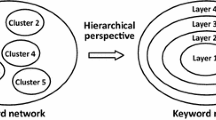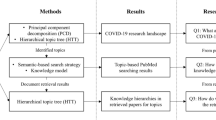Abstract
As a driver in modern science, interdisciplinary research has attracted a lot of attention. Major foci are laid on exploring the relations of multiple involved disciplines as well as the knowledge structure in interdisciplinary field. However, there is still a lack of decomposing the knowledge structure of interdisciplinary field to investigate how knowledge from relevant disciplines is integrated in the field. This study proposes an approach to investigating knowledge integration relationships between two research fields from a perspective of hierarchy. Medical Informatics (MI) and its most relevant field of Computer Science (CS) are chosen in the case study. This study decomposed each keyword network of the two fields into four layers by using the K-core method, then quantified the knowledge integration relationships between different layers of the two fields together. The results present that the MI basic layer shows the strongest knowledge integration with CS, followed by the middle layer, with the detail layer the weakest. And all MI layers have the greatest breadth and strength of knowledge integration with the CS middle layer, followed by the CS marginal layer and detail layer, but with the CS basic layer the weakest. A time series analysis shows that the integration of new CS knowledge into MI is a gradual process without explosive growth and the path of knowledge integration between the two fields were identified. The proposed approach could be applied to deeply understanding the integration of one discipline knowledge by an interdisciplinary field.








Similar content being viewed by others
Notes
It should be noted that the CS discipline defined by the 30 journals is a small subset of artificial intelligence field in computer science. Other fields of computer science are not covered, such as cybernetics, hardware, software engineering, etc.
References
Abramo, G., D’Angelo, C. A., & Costa, F. D. (2012). Identifying interdisciplinarity through the disciplinary classification of coauthors of scientific publications. Journal of the Association for Information Science & Technology, 63(11), 2206–2222.
Alvarez-Hamelin, J. I., Dall’Asta, L., Barrat, A., & Vespignani, A. (2005). k-core decomposition: a tool for the visualization of large scale networks. arXiv:cs/0504107.
Alvarez-Hamelin, J. I., Dall’Asta, L., Barrat, A., & Vespignani, A. (2017). K-core decomposition of Internet graphs: hierarchies, self-similarity and measurement biases. Networks & Heterogeneous Media, 3(2), 371–393.
Bergmann, T., Dale, R., Sattari, N., Heit, E., & Bhat, H. S. (2016). The interdisciplinarity of collaborations in cognitive science. Cognitive Science, 41(5), 1412–1418.
Besselaar, P. V. D., & Heimeriks, G. (2006). Mapping research topics using word-reference co-occurrences: A method and an exploratory case study. Scientometrics, 68(3), 377–393.
Braun, T., & Schubert, A. (2003). A quantitative view on the coming of age of interdisciplinarity in the sciences 1980–1999. Scientometrics, 58(1), 183–189.
Carmi, S., Havlin, S., Kirkpatrick, S., Shavitt, Y., & Shir, E. (2007). A model of Internet topology using k-shell decomposition. Proceedings of the National Academy of Sciences of the United States of America, 104(27), 11150–11154.
Chi, R., & Young, J. (2013). The interdisciplinary structure of research on intercultural relations: a co-citation network analysis study. Scientometrics, 96(1), 147–171.
Clauset, A., Moore, C., & Newman, M. E. (2008). Hierarchical structure and the prediction of missing links in networks. Nature, 453(7191), 98–101.
Cohen, J. (1960). A coefficient of agreement for nominal scales. Educational and Psychological Measurement, 20(1), 37–46.
Cole, S. (1983). The hierarchy of the sciences? American Journal of Sociology, 89(1), 111–139.
Collins, J. J., & Chow, C. C. (1998). It’s a small world. Nature, 393(6684), 409–410.
Dong, K., Xu, H., Rui, L., Ling, W., & Shu, F. (2018). An integrated method for interdisciplinary topic identification and prediction: a case study on information science and library science. Scientometrics, 115(2), 849–868.
Dorogovtsev, S. N., Goltsev, A. V., & Mendes, J. F. F. (2006). k-core organization of complex networks. Physical Review Letters, 96(4), 040601.
Eidsaa, M., & Almaas, E. (2013). S-core network decomposition: A generalization of k-core analysis to weighted networks. Physical Review E: Statistical, Nonlinear, and Soft Matter Physics, 88(6), 062819.
Griffiths, T. L., & Steyvers, M. (2004). Finding scientific topics. Proceedings of the National Academy Sciences of the United States of America, 101(1), 5228–5235.
Han, J. W., Pei, J., Yin, Y., Mao, R., et al. (2004). Mining frequent patterns without candidate generation: A frequent-pattern tree approach. Data Mining and Knowledge Discovery, 8(1), 53–87.
Hirst, G. (1978). Discipline impact factors: A method for determining core journal lists. Journal of the American Society for Information Science and Technology, 29(4), 171–172.
Hu, J., & Zhang, Y. (2017). Discovering the interdisciplinary nature of big data research through social network analysis and visualization. Scientometrics, 112(1), 91–109.
Karlovčec, M., & Mladenić, D. (2015). Interdisciplinarity of scientific fields and its evolution based on graph of project collaboration and co-authoring. Scientometrics, 102(1), 433–454.
Karunan, K., Lathabai, H. H., & Prabhakaran, T. (2017). Discovering interdisciplinary interactions between two research fields using citation networks. Scientometrics, 113(1), 335–367.
Khaouid, W., Barsky, M., Srinivasan, V., & Thomo, A. (2015). K-core decomposition of large networks on a single PC. Proceedings of the Vldb Endowment, 9(1), 13–23.
Lancichinetti, A., & Fortunato, S. (2012). Consensus clustering in complex networks. Scientific Reports, 2(13), 336.
Lee, B., & Jeong, Y. I. (2008). Mapping Korea’s national R&D domain of robot technology by using the co-word analysis. Scientometrics, 77(1), 3–19.
Lee, K., Jung, H., & Song, M. (2016). Subject–method topic network analysis in communication studies. Scientometrics, 109(3), 1–27.
Lee, P. C., Su, H. N., & Chan, T. Y. (2010). Assessment of ontology-based knowledge network formation by vector-space model. Scientometrics, 85(3), 689–703.
Leeuwen, T. N. V., & Moed, H. F. (2005). Characteristics of journal impact factors: The effects of uncitedness and citation distribution on the understanding of journal impact factors. Scientometrics, 63(2), 357–371.
Leydesdorff, L., & Rafols, I. (2011). Indicators of the interdisciplinarity of journals: Diversity, centrality, and citations. Journal of Informetrics, 5(1), 87–100.
Li, L. G., & Zhang, M. C. (2017). The construction of top disciplines should attach importance to developing discipline group and cross-discipline. Retrieved from http://epaper.gmw.cn/gmrb/html/2017-09/04/nw.D110000gmrb_20170904_1-11.htm. (in Chinese).
Liu, G. Y., Hu, J. M., & Wang, H. L. (2012). A co-word analysis of digital library field in China. Scientometrics, 91(1), 203–217.
Liu, Y., Tang, M., Zhou, T., & Do, Y. (2015). Core-like groups result in invalidation of identifying super-spreader by k-shell decomposition. Scientific Reports, 5, 9602.
Liu, Z., & Wang, C. (2005). Mapping interdisciplinarity in demography: a journal network analysis. Journal of Information Science, 31(4), 308–316.
Liu, P., & Xia, H. (2015). Structure and evolution of co-authorship network in an interdisciplinary research field. Scientometrics, 103(1), 101–134.
Lu, W., Huang, Y., Bu, Y., & Cheng, Q. (2018). Functional structure identification of scientific documents in computer science. Scientometrics, 115(3), 1–24.
Lucio-Arias, D., & Leydesdorff, L. (2008). Main-path analysis and path-dependent transitions in HistCite-based historiograms. Journal of the Association for Information Science & Technology, 59(12), 1948–1962.
Manning, C. D., Surdeanu, M., Bauer, J., Finkel, J., Bethard, S. J., & Mcclosky, D. (2014). The Stanford CoreNLP Natural Language Processing Toolkit. Proceedings of 52Nd Annual Meeting of the Association for Computational Linguistics: System Demonstrations. https://doi.org/10.3115/v1/P14-5010.
Mao, J., Lu, K., Zhao, W., & Cao, Y. (2018). How many keywords do authors assign to research articles–a multi-disciplinary analysis?. In Conference 2018 Proceedings.
Morillo, F., Bordons, M., & Gómez, I. (2001). An approach to interdisciplinarity through bibliometric indicators. Scientometrics, 51(1), 203–222.
Morris, T. A., & Mccain, K. W. (1998). The structure of medical informatics journal literature. Journal of American Medical Informatics Association, 5(5), 448–466.
Nanni, L., Paci, M., Brahnam, S., & Ghidoni, S. (2017). An ensemble of visual features for Gaussians of local descriptors and non-binary coding for texture descriptors. Expert Systems with Applications, 82(C), 27–39.
Nichols, L. G. (2014). A topic model approach to measuring interdisciplinarity at the National Science Foundation. Scientometrics, 100(3), 741–754.
Piepenbrink, A., & Nurmammadov, E. (2015). Topics in the literature of transition economies and emerging markets. Scientometrics, 102(3), 2107–2130.
Porter, A. L., & Chubin, D. E. (1985). An indicator of cross-disciplinary research. Scientometrics, 8(3–4), 161–176.
Porter, A. L., Cohen, A. S., Roessner, J. D., & Perreault, M. (2007). Measuring researcher interdisciplinarity. Scientometrics, 72(1), 117–147.
Rafols, I., & Meyer, M. (2010). Diversity and network coherence as indicators of interdisciplinarity: Case studies in bionanoscience. Scientometrics, 82(2), 263–287.
Sales-Pardo, M., Guimerà, R., Moreira, A. A., & Amaral, L. A. (2007). Extracting the hierarchical organization of complex systems. Proceedings of the National Academy of Sciences of the United States of America, 104(39), 15224–15229.
Salton, G., & Mcgill, M. J. (1988). The SMART and SIRE experimental retrieval systems. In Readings in information retrieval, 1988.
Schummer, J. (2004). Multidisciplinarity, interdisciplinarity, and patterns of research collaboration in nanoscience and nanotechnology. Scientometrics, 59(3), 425–465.
Song, M., & Kim, S. Y. (2013). Detecting the knowledge structure of bioinformatics by mining full-text collections. Scientometrics, 96(1), 183–201.
Stirling, A. (2007). A general framework for analysing diversity in science, technology and society. Journal of the Royal Society, Interface, 4(15), 707.
Valentin, F., Norn, M. T., & Alkaersig, L. (2016). Orientations and outcome of interdisciplinary research: the case of research behavior in translational medical science. Scientometrics, 106(1), 1–24.
Wang, X., Cheng, Q., & Lu, W. (2014). Analyzing evolution of research topics with NEViewer: A new method based on dynamic co-word networks. Scientometrics, 101(2), 1253–1271.
Wang, L., Notten, A., & Surpatean, A. (2013). Interdisciplinarity of nano research fields: A keyword mining approach. Scientometrics, 94(3), 877–892.
White, H. D., & McCain, K. W. (1997). Visualization of Literatures. Annual Review of Information Science and Technology, 32(1), 99–168.
Xiao, L., Chen, G., Sun, J., Han, S., & Zhang, C. (2016). Exploring the topic hierarchy of digital library research in China using keyword networks: A K-core decomposition approach. Scientometrics, 108(3), 1–17.
Xu, H., Guo, T., Yue, Z., Ru, L., & Fang, S. (2016). Interdisciplinary topics of information science: a study based on the terms interdisciplinarity index series. Scientometrics, 106(2), 583–601.
Zhang, H., Zhao, H., Cai, W., Liu, J., & Zhou, W. (2010). Using the k-core decomposition to analyze the static structure of large-scale software systems. Journal of Supercomputing, 53(2), 352–369.
Acknowledgements
This study was supported by the National Natural Science Foundation of China (71790612 and 71804135). We gratefully thank Dr. Zhe He in the School of Information at the Florida State University to help label the discipline information of the selected terms.
Author information
Authors and Affiliations
Corresponding authors
Rights and permissions
About this article
Cite this article
Ba, Z., Cao, Y., Mao, J. et al. A hierarchical approach to analyzing knowledge integration between two fields—a case study on medical informatics and computer science. Scientometrics 119, 1455–1486 (2019). https://doi.org/10.1007/s11192-019-03103-1
Received:
Published:
Issue Date:
DOI: https://doi.org/10.1007/s11192-019-03103-1




